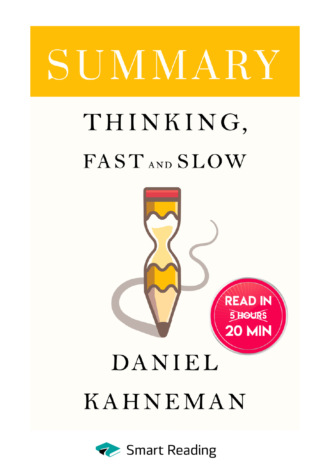
Smart Reading
Summary: Thinking, Fast and Slow. Daniel Kahneman
Автор:
Daniel Kahneman
Оригинальное название:
Thinking, Fast and Slow
www.smartreading.ru
Two Systems of Thinking
We can usually tell what we're thinking. The process of thinking seems clear: one conscious thought naturally causes the next one. But basically, the mind works differently. Most of our thoughts arise in unknown ways, and the mental work that leads to impressions, hunches, and decisions usually goes unnoticed.
There are two modes of thinking. To define the first mode – intuitive, spontaneous – the term "fast thinking" is used, and the second one – conscious, reasonable – is called "slow thinking".
Fast thinking activates automatically and instantly, requiring little or no effort. Slow thinking involves having the attention necessary for conscious mental effort, including complex calculations. Fast thinking generates impressions and feelings, while slow thinking actions are often associated with a sense of activity, choice, and focus. The automatic actions of fast thinking build complex patterns of thoughts, but only slow thinking can build them into an ordered sequence. Both systems have their own unique abilities, limitations and functions. What can fast thinking do? For example, it allows us to determine which of two objects is closer, discern the source of a loud sound, make a grimace of disgust at the sight of a disgusting picture, drive a car on an empty road, understand a simple sentence, reveal hostility in our voice, etc. These actions happen automatically and require no effort. The ability to think fast is our inner skill. We are born ready to perceive the world, recognize objects, avoid losses and be afraid of spiders. Other activities of the mind become fast and automatic after much practice.
Fast thinking includes expert knowledge and unconscious attitude, as well as all those absolutely automatic actions of the brain in the field of perception and memory that help us remember exactly the capital of England or recognize that there is a lamp on the table. But from time to time a reasonable answer doesn't come to mind, and in such cases we switch to a deeper form of thinking that requires more effort. This is slow thinking. With the help of slow thinking, you can prepare for the start signal in the race, hear the voice of the right person in a crowded noisy room, remember a sound that startled you by rummaging through your memory banks, intentionally speed up your pace, dictate your phone number to the person you are speaking to, etc. In all these situations, you need to be attentive, and if you are not ready or distracted, you will fare even worse, if not manage at all. One of the main functions of slow thinking is to monitor and control the thoughts and actions prompted by fast thinking.
Slow and fast thinking can interact. Fast thinking works automatically, while slow thinking works in a comfortable mode of minimal effort. Fast thinking constantly generates offers for slow thinking: impressions, premonitions, intentions and feelings. If slow thinking approves of them, then impressions and premonitions turn into convictions, and impulses into intentional actions. When everything goes smoothly – and it almost always does – the slow thinking accepts the offer of the fast thinking with little or no change. As a rule, you believe your impressions and act according to your desires, which is quite acceptable.
When fast thinking encounters difficulties it turns to slow thinking to solve the problem at hand with more detailed processing. That is, slow thinking tries to answer the question that fast thinking does not have an answer to. For example, do the math of 17 × 24. In other words, slow thinking comes into play when a question is discovered to which fast thinking has no answer. Slow thinking is responsible for the constant control of your behavior. Thanks to slow thinking you are able to remain polite in a rage and attentive when driving at night. Slow thinking is mobilized if it detects that you are about to make a mistake. Like when you remember how you almost blurted out something offensive and how difficult it was for you to control yourself. In general, most of what you (your slow thinking) think and do is generated by fast thinking, but in times of difficulty, slow thinking takes control and usually has the final say.
The division of labor between the two systems is very efficient. Most of the time, everything is fine, because fast thinking does its job very well: it forms accurate models of situations and short-term forecasts, and quickly responds to new tasks. However, fast thinking also has its distortions and systematic errors that it tends to make in certain circumstances. At times, it answers not what was asked, but an easier questions and is therefore poorly versed in logic and statistics. Another limitation of fast thinking is that it cannot be turned off. When you see a word in a familiar language on the screen, you will read it, unless your attention is diverted by something else.







